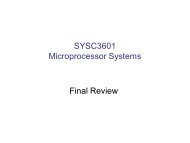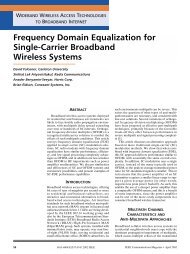Image Reconstruction for 3D Lung Imaging - Department of Systems ...
Image Reconstruction for 3D Lung Imaging - Department of Systems ...
Image Reconstruction for 3D Lung Imaging - Department of Systems ...
You also want an ePaper? Increase the reach of your titles
YUMPU automatically turns print PDFs into web optimized ePapers that Google loves.
3.7 Summary<br />
3.7.1 <strong>Reconstruction</strong> Summary<br />
Here we summarize the state <strong>of</strong> the art in EIT difference imaging <strong>for</strong> clinical applications<br />
such as pulmonary imaging. The framework is the non-linear optimization problem, equation<br />
3.7, which is reproduced below:<br />
ˆx = arg min<br />
x<br />
�<br />
�Hx − z� 2 + λ 2 �Rx� 2�<br />
(3.24)<br />
This is solved using the MAP regularized framework <strong>of</strong> equation 3.22 again repeated below:<br />
ˆx = (H T WH + λ 2 R T R) −1 H T Wz = B(λ)z (3.25)<br />
where z = v2 − v1. The framework has several explicit parameters that must be selected<br />
by the user:<br />
1. The regularization hyperparameter, λ, is the subject <strong>of</strong> chapter 4.<br />
2. The norm <strong>of</strong> the prior, �Rx� 2 , has historically been the ℓ 2 norm. The ℓ 1 norm has<br />
been used <strong>for</strong> “blocky” reconstructions. An algorithm <strong>for</strong> solving the ℓ 1 norm is<br />
evaluated in chapter 7.<br />
3. The prior matrix, R, has many possibilities as discussed in this chapter.<br />
4. The data weighting matrix W has the ability to consider noise and erroneous electrode<br />
data. However with equal noise variance on each measurement channel and with good<br />
electrodes (no accounting <strong>for</strong> erroneous electrodes), W becomes a scaled version <strong>of</strong><br />
the identity matrix.<br />
In addition to these explicit parameters there are several implied parameters that con<strong>for</strong>m<br />
to some assumptions:<br />
1. The initial conductivity, σ0, is typically assumed to be homogenous.<br />
2. The conductivity used to calculate the Jacobian, σ ∗ , is typically assumed to be homogenous.<br />
3. FEM modeling issues including degree <strong>of</strong> the shape functions (linear, quadratic),<br />
isotropy <strong>of</strong> element conductivity, and mesh parameters such as number and degree<br />
(triangle, quadrilateral) <strong>of</strong> elements, geometry, shape <strong>of</strong> the reconstructed mesh dimension<br />
(2 or 3).<br />
4. Electrode types, locations and size.<br />
5. Current injection and measurement patterns.<br />
None <strong>of</strong> these parameters appear explicitly in equations 3.24 or 3.25 but are important<br />
parts <strong>of</strong> the problem. There is much work describing variations <strong>of</strong> the framework in terms<br />
<strong>of</strong> explicit and implied parameters, however, there is little quantitative in<strong>for</strong>mation on how<br />
they compare and how important any one <strong>of</strong> them is.<br />
45





